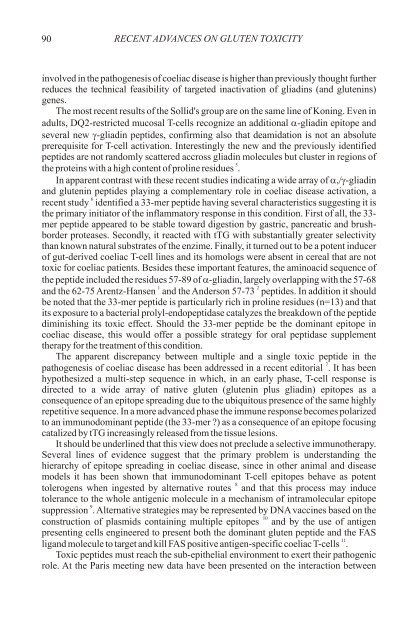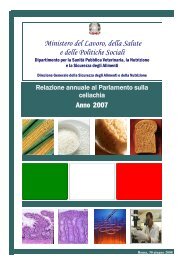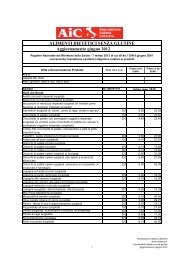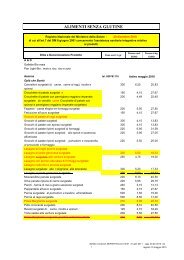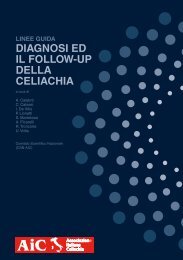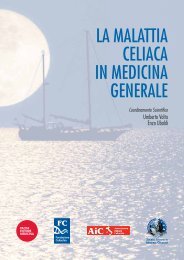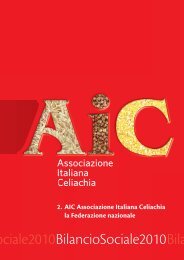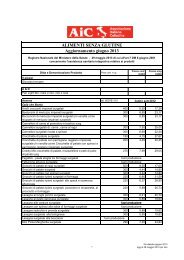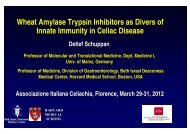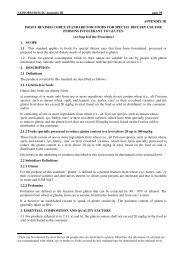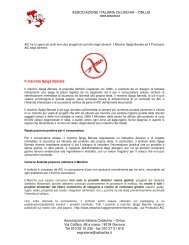primary prevention of coeliac disease - Associazione Italiana ...
primary prevention of coeliac disease - Associazione Italiana ...
primary prevention of coeliac disease - Associazione Italiana ...
Create successful ePaper yourself
Turn your PDF publications into a flip-book with our unique Google optimized e-Paper software.
90<br />
RECENT ADVANCES ON GLUTEN TOXICITY<br />
involved in the pathogenesis <strong>of</strong> <strong>coeliac</strong> <strong>disease</strong> is higher than previously thought further<br />
reduces the technical feasibility <strong>of</strong> targeted inactivation <strong>of</strong> gliadins (and glutenins)<br />
genes.<br />
The most recent results <strong>of</strong> the Sollid's group are on the same line <strong>of</strong> Koning. Even in<br />
adults, DQ2-restricted mucosal T-cells recognize an additional a-gliadin epitope and<br />
several new g-gliadin peptides, confirming also that deamidation is not an absolute<br />
prerequisite for T-cell activation. Interestingly the new and the previously identified<br />
peptides are not randomly scattered accross gliadin molecules but cluster in regions <strong>of</strong><br />
5<br />
the proteins with a high content <strong>of</strong> proline residues .<br />
In apparent contrast with these recent studies indicating a wide array <strong>of</strong> a,/g-gliadin<br />
and glutenin peptides playing a complementary role in <strong>coeliac</strong> <strong>disease</strong> activation, a<br />
6<br />
recent study identified a 33-mer peptide having several characteristics suggesting it is<br />
the <strong>primary</strong> initiator <strong>of</strong> the inflammatory response in this condition. First <strong>of</strong> all, the 33-<br />
mer peptide appeared to be stable toward digestion by gastric, pancreatic and brushborder<br />
proteases. Secondly, it reacted with tTG with substantially greater selectivity<br />
than known natural substrates <strong>of</strong> the enzime. Finally, it turned out to be a potent inducer<br />
<strong>of</strong> gut-derived <strong>coeliac</strong> T-cell lines and its homologs were absent in cereal that are not<br />
toxic for <strong>coeliac</strong> patients. Besides these important features, the aminoacid sequence <strong>of</strong><br />
the peptide included the residues 57-89 <strong>of</strong> a-gliadin, largely overlapping with the 57-68<br />
1 2<br />
and the 62-75 Arentz-Hansen and the Anderson 57-73 peptides. In addition it should<br />
be noted that the 33-mer peptide is particularly rich in proline residues (n=13) and that<br />
its exposure to a bacterial prolyl-endopeptidase catalyzes the breakdown <strong>of</strong> the peptide<br />
diminishing its toxic effect. Should the 33-mer peptide be the dominant epitope in<br />
<strong>coeliac</strong> <strong>disease</strong>, this would <strong>of</strong>fer a possible strategy for oral peptidase supplement<br />
therapy for the treatment <strong>of</strong> this condition.<br />
The apparent discrepancy between multiple and a single toxic peptide in the<br />
7<br />
pathogenesis <strong>of</strong> <strong>coeliac</strong> <strong>disease</strong> has been addressed in a recent editorial . It has been<br />
hypothesized a multi-step sequence in which, in an early phase, T-cell response is<br />
directed to a wide array <strong>of</strong> native gluten (glutenin plus gliadin) epitopes as a<br />
consequence <strong>of</strong> an epitope spreading due to the ubiquitous presence <strong>of</strong> the same highly<br />
repetitive sequence. In a more advanced phase the immune response becomes polarized<br />
to an immunodominant peptide (the 33-mer ?) as a consequence <strong>of</strong> an epitope focusing<br />
catalized by tTG increasingly released from the tissue lesions.<br />
It should be underlined that this view does not preclude a selective immunotherapy.<br />
Several lines <strong>of</strong> evidence suggest that the <strong>primary</strong> problem is understanding the<br />
hierarchy <strong>of</strong> epitope spreading in <strong>coeliac</strong> <strong>disease</strong>, since in other animal and <strong>disease</strong><br />
models it has been shown that immunodominant T-cell epitopes behave as potent<br />
8<br />
tolerogens when ingested by alternative routes and that this process may induce<br />
tolerance to the whole antigenic molecule in a mechanism <strong>of</strong> intramolecular epitope<br />
9<br />
suppression . Alternative strategies may be represented by DNA vaccines based on the<br />
10<br />
construction <strong>of</strong> plasmids containing multiple epitopes and by the use <strong>of</strong> antigen<br />
presenting cells engineered to present both the dominant gluten peptide and the FAS<br />
11<br />
ligand molecule to target and kill FAS positive antigen-specific <strong>coeliac</strong> T-cells .<br />
Toxic peptides must reach the sub-epithelial environment to exert their pathogenic<br />
role. At the Paris meeting new data have been presented on the interaction between


